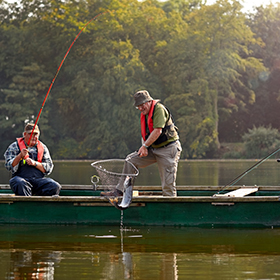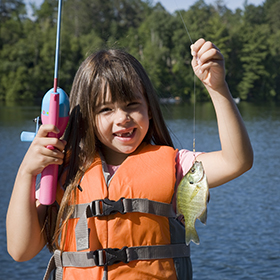The basic jig is one of the most versatile baits that a bass angler can have in their arsenal. It can be fished just about any way, in any depth, and around most types of cover and structure.
The basic jig is one of the most versatile baits that a bass angler can have in their arsenal. It can be fished just about any way, in any depth, and around most types of cover and structure. Yet, in some ways, a jig is among the most complex of baits, due to the fact that every detail can be fine-tuned to best fit a variety of situations. Because of the customizable nature of the jig, over time bass anglers have developed individual styles to handle specific techniques.
As you learn more about fishing jigs, you’ll come to appreciate the advantages that each of these styles provides.
1. Swim Jig
.jpg)
How to fish it: The swim jig is designed to come through grass and wood, but it’ll get bites in open water too. Just don’t drag it. Swim it. Sometimes a straight retrieve is desirable, but another common technique is to shake the rod tip while reeling. It can be fished right at the surface, scraping along the bottom or in between.
Size selection: 3/16 to 1/2 ounce for shallow presentations; 3/4-ounce and heavier for slow-rolling in deep water or blowing through heavy grass.
Other details:
- Use white or silver colors when imitating shad and combinations of green, brown, purple and orange when imitating bluegills.
- A swim jig should have a reliable bait-holder – either a large lead barb or a metal wire – to hold the trailer in place.
- Trim the skirt short enough that it doesn’t hang down over the moving parts of the trailer.
2. Football Jig

How to fish it: The football jig is the king of offshore fishing thanks to its head shape, which is designed to not tip over when dragged on bottom on ledges, points and the like. It’s also a great tool to feel the bottom content. To fish it, simply pull the jig along a bit, take up the slack and repeat. Reel up slack line before setting the hook. A football jig can also be stroked up and down off the bottom.
The technique: Rip it up, then let it sink back on a slack or semi-slack line. Fish usually bite on the fall.
Size selection: 1/2 to 1 ounce for most situations; 1 1/4 and 1 1/2 ounce for extreme depths.
Other details:
- If you’re not fishing around brush or wood cover, consider thinning out the weedguard. This can help improve the hookup ratio.
3. Flipping Jig

How to fish it: There’s quite a bit of variation in flipping jig design. Some of that stems from the variety of cover types that anglers flip and the fact that some jigs are designed to be versatile enough for other techniques. Typically, a flipping jig is a target bait for making short flips, pitches and roll-casts to shallow wood, shoreline grass, deeper grass beds (in some situations) and docks. Once the bait reaches the target, let it fall, hop it a time or two, and then reel it back in for the next flip. Shoot for a quiet entry into the water each time.
Size selection: 3/8 to 3/4 ounce
Other details:
- Fall rate can be critical when flipping. Adjust fall rate by changing jighead size, skirt thickness and length, and the style of the trailer. The more compact the package, the faster it’ll sink. Leave the skirt full to slow the sink rate.
4. Punch Jig

How to fish it: A punch jig is a specialized flipping jig designed to break through matted grass. It’s also a good option for flipping deep submerged grass or thick wood cover, or when you want a really bulky, fast-sinking presentation. Sometimes it’s necessary to pitch the jig up in the air so it can build some speed on the fall to get through the grass. In most cases, a punch jig should be fished with braid, which can cut through grass stems and turn a fish in thick cover.
Size selection: 3/4 to 2 ounces
Other details:
- Some punch jigs have double weedguards for even more deflection.
- Compact trailers without a lot of “flappy” appendages tend to slide through cover more easily than bulky trailers.
5. Finesse Jig

How to fish it: Technique depends on the scenario, but a finesse jig can be target fished, dragged, skipped under cover or bombed over structure. The key is to fish it very slowly, usually with soft tugs or short lifts of the rod tip.
Size selection: 3/16 to 3/8 ounce
Other details:
- Tungsten is a good choice for a finesse jig.
- To spider-cut a skirt, pull the front half of the strands over the head, hold them together, and trim the strands right in front of the head.
- Round rubber skirts strands are sometimes preferred in cold water because they flare and pulsate even when the jig is barely moving.
6. Casting/Structure Jig

How to fish it: The casting/structure jig is the basic all-purpose jig that can be skipped, pitched or flipped, but it excels in dragging presentations on sloping rocky banks, flats, points and other middepth structure. One key is that the jig is compact enough that a bass can easily suck it off bottom. But more importantly, it needs a head design that allows it to crawl over rocks without snagging. Thus, most have a flat bottom, such as an Arkie-style jig or the more recent structure-style head that resembles a squished down football. Some are pointed and resemble arrowheads. Drag the jig along bottom with short tugs or a lift-drop technique.
Size selection: 3/16 to 5/8 ounce
Other details:
- Try trimming the skirt by holding the jig upside down and cutting diagonally across the strands with scissors. The result will be a wide range of strand lengths and a skirt that pulses.
To learn more about fishing tackle and techniques firsthand from expert FLW anglers, check out the #ReelFun fishing events taking place at Walmart stores across the U.S. June 2-4, 2017. Find dates and times at TakeMeFishing.org
Curtis Niedermier currently serves as the Editor-in-Chief of FLW Bass Fishing Magazine
This article was originally posted at FLWFishing.com.
As you learn more about fishing jigs, you’ll come to appreciate the advantages that each of these styles provides.
1. Swim Jig
.jpg)
How to fish it: The swim jig is designed to come through grass and wood, but it’ll get bites in open water too. Just don’t drag it. Swim it. Sometimes a straight retrieve is desirable, but another common technique is to shake the rod tip while reeling. It can be fished right at the surface, scraping along the bottom or in between.
Size selection: 3/16 to 1/2 ounce for shallow presentations; 3/4-ounce and heavier for slow-rolling in deep water or blowing through heavy grass.
Other details:
- Use white or silver colors when imitating shad and combinations of green, brown, purple and orange when imitating bluegills.
- A swim jig should have a reliable bait-holder – either a large lead barb or a metal wire – to hold the trailer in place.
- Trim the skirt short enough that it doesn’t hang down over the moving parts of the trailer.
2. Football Jig

How to fish it: The football jig is the king of offshore fishing thanks to its head shape, which is designed to not tip over when dragged on bottom on ledges, points and the like. It’s also a great tool to feel the bottom content. To fish it, simply pull the jig along a bit, take up the slack and repeat. Reel up slack line before setting the hook. A football jig can also be stroked up and down off the bottom.
The technique: Rip it up, then let it sink back on a slack or semi-slack line. Fish usually bite on the fall.
Size selection: 1/2 to 1 ounce for most situations; 1 1/4 and 1 1/2 ounce for extreme depths.
Other details:
- If you’re not fishing around brush or wood cover, consider thinning out the weedguard. This can help improve the hookup ratio.
3. Flipping Jig

How to fish it: There’s quite a bit of variation in flipping jig design. Some of that stems from the variety of cover types that anglers flip and the fact that some jigs are designed to be versatile enough for other techniques. Typically, a flipping jig is a target bait for making short flips, pitches and roll-casts to shallow wood, shoreline grass, deeper grass beds (in some situations) and docks. Once the bait reaches the target, let it fall, hop it a time or two, and then reel it back in for the next flip. Shoot for a quiet entry into the water each time.
Size selection: 3/8 to 3/4 ounce
Other details:
- Fall rate can be critical when flipping. Adjust fall rate by changing jighead size, skirt thickness and length, and the style of the trailer. The more compact the package, the faster it’ll sink. Leave the skirt full to slow the sink rate.
4. Punch Jig

How to fish it: A punch jig is a specialized flipping jig designed to break through matted grass. It’s also a good option for flipping deep submerged grass or thick wood cover, or when you want a really bulky, fast-sinking presentation. Sometimes it’s necessary to pitch the jig up in the air so it can build some speed on the fall to get through the grass. In most cases, a punch jig should be fished with braid, which can cut through grass stems and turn a fish in thick cover.
Size selection: 3/4 to 2 ounces
Other details:
- Some punch jigs have double weedguards for even more deflection.
- Compact trailers without a lot of “flappy” appendages tend to slide through cover more easily than bulky trailers.
5. Finesse Jig

How to fish it: Technique depends on the scenario, but a finesse jig can be target fished, dragged, skipped under cover or bombed over structure. The key is to fish it very slowly, usually with soft tugs or short lifts of the rod tip.
Size selection: 3/16 to 3/8 ounce
Other details:
- Tungsten is a good choice for a finesse jig.
- To spider-cut a skirt, pull the front half of the strands over the head, hold them together, and trim the strands right in front of the head.
- Round rubber skirts strands are sometimes preferred in cold water because they flare and pulsate even when the jig is barely moving.
6. Casting/Structure Jig

How to fish it: The casting/structure jig is the basic all-purpose jig that can be skipped, pitched or flipped, but it excels in dragging presentations on sloping rocky banks, flats, points and other middepth structure. One key is that the jig is compact enough that a bass can easily suck it off bottom. But more importantly, it needs a head design that allows it to crawl over rocks without snagging. Thus, most have a flat bottom, such as an Arkie-style jig or the more recent structure-style head that resembles a squished down football. Some are pointed and resemble arrowheads. Drag the jig along bottom with short tugs or a lift-drop technique.
Size selection: 3/16 to 5/8 ounce
Other details:
- Try trimming the skirt by holding the jig upside down and cutting diagonally across the strands with scissors. The result will be a wide range of strand lengths and a skirt that pulses.
To learn more about fishing tackle and techniques firsthand from expert FLW anglers, check out the #ReelFun fishing events taking place at Walmart stores across the U.S. June 2-4, 2017. Find dates and times at TakeMeFishing.org
Curtis Niedermier currently serves as the Editor-in-Chief of FLW Bass Fishing Magazine
This article was originally posted at FLWFishing.com.









